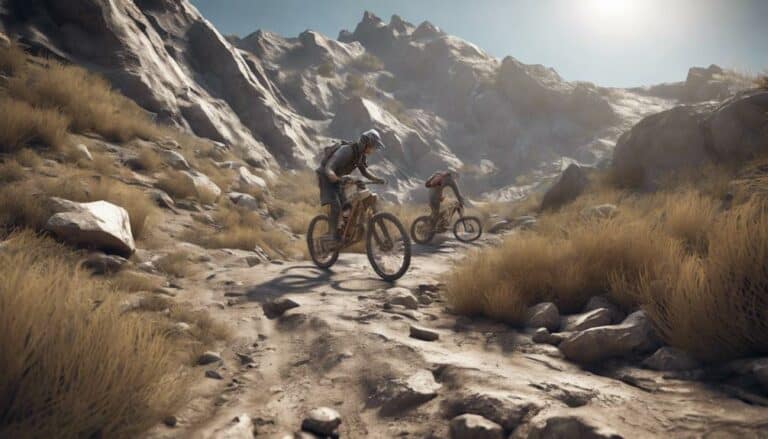Are you prepared to tackle various terrains on off-road riding trails with ease and confidence? Understanding the best techniques for handling mud, rocks, sand, hills, forests, snow, and pavement can greatly enhance your off-road riding experience.
By adjusting your riding style to suit the terrain, you can navigate challenging landscapes more effectively. Stay tuned to discover expert tips on mastering different types of terrain and elevating your off-road riding skills to the next level.
Key Takeaways
- Maintain momentum in mud, precise navigation on rocks, balanced weight on sand, and proper throttle control on hills.
- Equip suitable tires and accessories, carry essential tools, and wear safety gear for off-road riding preparedness.
- Use lower gear and steady acceleration uphill, cautious downhill steering, and careful navigation through mud and water.
- Focus on accurate line selection, body positioning, steady speed, and obstacle anticipation for rocky terrain maneuvering.
Understanding Terrain Types
Understanding the various types of terrain is important for mastering off-road riding techniques and ensuring a safe and efficient journey. When engaging in off-road riding, you'll encounter a diverse range of terrain types such as mud, rocks, sand, hills, forests, snow, and even paved ground. Each terrain type presents unique challenges that necessitate specific riding techniques to navigate effectively.
Mud, for instance, requires maintaining momentum to prevent getting stuck, while rocks demand precise navigation to avoid damaging your vehicle. Sand necessitates a balanced weight distribution and tire pressure adjustment for improved traction. Hills call for proper body positioning and throttle control to ascend and descend safely. Forest trails may require maneuvering around obstacles and tight corners. Snow riding demands special tires and cautious acceleration to prevent sliding. Paved surfaces mandate adherence to local laws for safety and environmental conservation.
Gear Up for the Challenge
Gear up for the challenge by making sure you have the appropriate protective gear such as helmets, goggles, gloves, and sturdy boots before starting on off-road riding adventures across diverse terrains. When gearing up for your off-road experience, consider the following:
- Tire Selection: Equip your vehicle with tires suitable for the specific terrain, like all-terrain or mud tires, to enhance traction and control.
- Vehicle Accessories: Enhance protection and capability by adding accessories such as skid plates, rock sliders, and winches to tackle challenging terrains effectively.
- Essential Tools: Carry crucial tools like a first aid kit, tire repair kit, tow straps, and a GPS device to handle emergencies and navigate unfamiliar terrain seamlessly.
- Vehicle Maintenance: Regularly maintain and inspect your vehicle to make sure it's in top condition for safe and efficient riding, especially when facing challenges like riding on ice.
Mastering Uphill and Downhill Riding
When tackling uphill and downhill terrain on off-road trails, mastering the proper techniques is essential for maintaining control and safety throughout your ride. Uphill riding requires driving straight uphill in a lower gear to maintain traction. Accelerate before starting the climb to prevent stalling and guarantee momentum.
To prevent tipping over, maintain a steady speed and apply gentle throttle while climbing. Be cautious on steep inclines to avoid rollovers – sudden acceleration can lead to loss of control.
Downhill riding demands steering downhill if your vehicle begins to roll over on a side hill. This action helps regain control and prevent accidents. When driving on side hills, exercise extreme caution as slippery surfaces can cause uncontrollable sliding.
Navigating Through Mud and Water
Driving through mud and water requires precise vehicle control and strategic decision-making to overcome challenging terrain conditions. When riding through these conditions, it's important to maintain control and keep a few key tips in mind:
- Maintain Speed: Keep a steady pace and avoid sudden speed changes to prevent getting stuck in mud.
- Utilize Momentum: Use momentum to smoothly glide through water and mud pits without coming to a halt.
- Safe Distance: Maintain a safe distance from other vehicles to prevent splashing mud and water, which can lead to visibility issues.
- Choose Solid Paths: Opt for paths with solid ground underneath to avoid the risk of sinking into deep mud or water.
Remember to always be aware of your surroundings and choose your route wisely.
After riding through these challenging terrains, make sure to thoroughly clean your vehicle to prevent damage and corrosion. By following these guidelines, you can navigate through mud and water with confidence and skill.
Techniques for Rocky Terrain
Traversing rocky terrain demands accurate line selection to make certain a smooth and safe ride over the rugged surfaces. As an experienced rider, mastering techniques for rocky terrain is important. Your body positioning plays a crucial role in maneuvering this challenging landscape. Position yourself slightly back on the seat, standing on the footpegs with bent knees, and keep your elbows up. This stance allows your body to absorb the impact of the rocks, maintaining stability and control.
Maintain a steady speed to glide over the rocks smoothly, preventing your tires from getting stuck or losing traction. A firm grip on the handlebars is essential to steer through obstacles effectively. Stay focused on the terrain ahead, anticipating the best path to follow. Being proactive in adjusting your course will help you conquer rocky terrain with confidence.
Make sure your off-road vehicle is equipped with suitable tires and suspension to handle the rugged nature of rocky terrain. By combining proper body positioning, steady speed, and focused attention, you can traverse rocky terrain like a seasoned rider.
Conclusion
To sum up, tackling different terrains on off-road trails is like mastering a dance with nature. By adjusting your riding style, gearing up appropriately, and mastering techniques for each type of terrain, you can glide through the trails with ease and confidence.
Remember, like a skilled performer, adaptability and technique are key to maneuvering the diverse landscapes of off-road riding. So gear up, embrace the challenge, and let the trail be your stage to showcase your skills.

